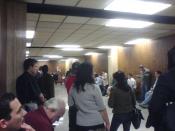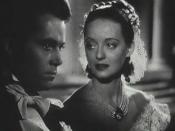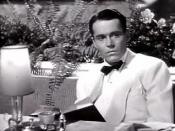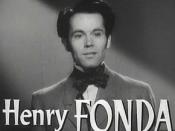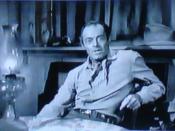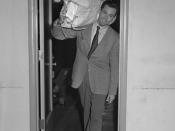The movie "Twelve Angry Men" is about a young man who is accused of stabbing his father to death. The twelve jurors have to decide whether the defendant is guilty or innocent. If the young man is found guilty, there is a mandatory death sentence (the jury needs to be unanimous in their decision). At the preliminary vote, eleven of the twelve jurors vote the young man guilty. Henry Fonda is the only one who voted the accused as not guilty because he doesn't want to send the defendant to the death penalty without discussing it. Throughout the movie, Henry uses various styles of leadership in which I will discuss further in the following section.
Question 1:At the beginning, Henry uses the supporting style of leadership from Hersey and Blanchard's Situational Leadership framework. In this style, Henry demonstrates low task focus and high relationship focus. As mentioned previously, at the beginning of the deliberation process Henry is the only one who votes not guilty, everybody else voted guilty without really thinking about their decision.
Henry wanted to talk about it before making a serious decision concerning a young man's life. Compared to other jurors, Henry was trying to create a discussion rather than an argument. He expressed no adherence to either position but wanted to discuss the case in an open-minded manner. Although other jurors got mad and started yelling, Henry stayed calmed throughout the situation and was a good listener. He was trying to find out why the other jurors voted guilty and trying to get their cooperation (this was seen when Henry was elaborating on the juror's explanations of their choice for voting guilty). As well, he was trying to motivate individuals within the group and keep them focused; however several jurors were not cooperating and there was a lack of commitment (although the jurors possess the competence to come to an agreement). They were constantly interrupting him, shouting, and at one point two jurors were playing 'tic-tac-toe'. They were not open-minded and didn't want to listen to what others had to say. Almost everyone in the room wanted to leave but in the end Henry was able to get others to reconsider their position. This leadership style was appropriate when comparing it to the group's readiness. Although the jurors were able to examine this case in greater details, they were refusing to do so and were not showing any commitment. Henry was able to persuade them to cooperate and participate (high focus on relationship) in which it led him into another leadership style approach; coaching.
A second leadership style that was used by Henry was the coaching style. In this style, Henry demonstrates high task focus and high relationship focus. The jurors were somewhat willing to discuss the situation but Henry reinforced his suggestion of talking about it before making any final decision. The jury did have the competence to agree on a verdict but lacked commitment. They needed direction from the leader in order to get them going. By persuading the old man to change his vote, it gave the group an opportunity to discussion the situation. As a result, Henry was able to change others minds and feelings concerning the young man.
Throughout the deliberation, Henry gave his opinion and created new options and ideas in which he raised valid and logical points. He looked at the situation from different point of views, for instance; when they investigated the witnesses' credibility. He analyzed several facts from the night of the murder and he re-enacted certain scenes in order to prove his point. The re-enactment eventually got the interest of others in the room in which it triggered their curiosity to hear what Henry had to say. He had several counter arguments throughout the deliberation asking others questions concerning the situation, for instance; is it possible the boy lost his knife and someone else stabbed his father with a similar knife? He got others to reflect about the situation more seriously without telling them exactly what to do. He exhibited high relationship with other jurors when they began to discuss the situation more seriously, for instance; when they discussed the murder weapon and another juror showed interest, Henry quickly turned his attention to him. Throughout the deliberation he respected quiet members and formed alliances. This leadership style was effective because Henry couldn't have told others what to do but the jurors needed direction. He wasn't very direct in his approach in the sense of telling them what to do or else he may have encountered a great amount of resistance. Instead he got the flow of communication going by stating his opinion and clarifying his thoughts which got the involvement of others.
I don't believe the other two leadership styles were used to a great extent by Henry. I don't recall him using the directing style in which as a leader he tells others what to do. Many of the discussions in the deliberating room were provoked by Henry; however he did not have to tell anyone what to do. For example, Henry began the discussion of the murder weapon however Lee Cobb is the one who asked about the credibility of the old man and his testimony. The discussion of the angle of the stab wound was initiated by John Fiedler, and Joseph Sweeney discovered the indented impressions on Jack Klugman's nose in which the old woman had the same marks. As well, the delegating style was not used because of the lack of motivation and willingness demonstrated by the followers. Henry wasn't able to sit back and trust the group to get on with the task of discussing the situation.
Throughout the movie, Henry portrayed the appropriate attitudes and leadership style according to the readiness level of the group. He emerged as a leader because of the respect that he earned and his ability to be both task and maintenance oriented. He was honest and open to exploration and remained open-minded throughout the deliberation.
Question 3:As stated by Rothwell (2007) a power resource is anything that helps individuals attain their goals. Essentially there are five primary power resources that an individual can possess, such as; information, expertise, punishments and rewards, personal qualities, and legitimate authority (p.301-302). Throughout the jury deliberation there are several primary power resources that are exhibited by different jurors. I will describe the power resources of three members of the jury; Henry Fonda, Jack Klugman, and Joseph Sweeny.
To begin with, Henry displayed power resources in two areas: personal qualities and legitimate authority. Throughout the deliberation, Henry was able to influence others especially with his charisma. He was able to change the minds and actions of others with different tactics. Henry possesses great communication skills and he is able to persuade others with his intelligence. He took the situation seriously and wanted to discuss it rationally before making any decisions. Throughout the discussion he remained calm and had the courage to face others. It seems like Henry knew which actions were appropriate in different circumstances, for instance; when to argue or ask questions. He portrayed a character that gained respect from others; as a result he emerged as a leader. He was able to elaborate on other's thoughts which helped keep the group focused on the situation. Henry was able to influence the group because of the influence he possessed over them. The fact that Henry emerged as a leader gave him greater authority compared to others. His vote at the beginning gave him the greatest power - he was the only one who voted not guilty. Henry's power resources had several influences on the final outcome of the deliberation because he had influence on the decisions of the other jurors.
Jack displayed power resources with his expertise. His expertise emerged near the end of the deliberation when the group was discussing the angle of the stab wound. Various jurors were trying to figure out how the angle could have been downwards and that it was very awkward. They re-enacted the scene and came to a conclusion; however Jack had a counter-argument. He was able to use valuable and useful information that others did not possess. Jack had previous experience with a switchblade knife and explained to the group how anyone who's ever used one would handle it. He was able to convince others with his expertise and influenced their decisions. This had an influence on the final outcome because they came to a conclusion that perhaps the young man did not stab his father.
Joseph displayed power resources through information power when the group was discussing the credibility of the testimony of the old man and old woman. During this discussion, Henry was speculating with the facts obtained in the trial and tried to make sense of it. He uses information as power because it is unavailable to others. The fact that he is an old man himself makes it easier for him to understand the situation which he then explained to the group, for instance; the old man wouldn't lie but perhaps he made himself believe that he heard those words. Having information that is perceived to be unavailable to others does have a great influence on the rest of the group and their decision to vote not guilty.
Even though the three jurors mentioned above brought different power resources to the group, the fact that these power resources received support from the rest of the group made them influential.
Question 5:Unanimity rule is often used in juries in which all members must agree on the decision. As explained by Rothwell (2007), a consensus is reached when all members have had the opportunity to express their opinions or concerns. A true consensus requires three elements: agreement, commitment, and satisfaction of all members. Members must be able to say that they agree and support the decision (p.263).
Throughout the deliberation we see each juror basically change their vote one at a time; however a viable explanation for their reasoning was not always given. Joseph Sweeney changed his vote to give Henry support, George Voskovec changed his mind because of his reasonable doubt, and Jack Warden because he wants to be dismissed.
The group was able to discuss the situation and stated their concerns in which they studied in various ways (i.e. re-enactment). They had no time constraints to reach a consensus decision. All of the jurors' voices were heard in the process; they had a chance to express their view although at the beginning jurors did not speak up because they were afraid of more dominant jurors such as Lee Cobb. But in the end they were able to collectively discuss the situation.
I don't believe the group came to a true consensus because not every individual supports the group's decision. It is not true consensus when an individual agree because they don't want to spend more time than necessary in the deliberation. Jack Warden clearly stated when changing his vote that he was sick of all the talking and wanted to attend the ball game. As well, each individual should understand and agree with the issue, in this case the young man being not guilty, and must support the group's final decision. I don't believe there is support from all twelve jurors because "once unanimous agreement has been reached, members must be willing to defend the decision to outsiders" (Rothwell, 2007, p.263). It seems like some jurors may have changed their vote because of social pressures. As well, it was never argued that the young man is innocent simply that others couldn't prove he was guilty beyond a reasonable doubt.
There are various concepts of leadership displayed throughout the movie "Twelve Angry Men". Henry Fonda emerged as a leader because of his motivation and respect earned from others. Although he was surrounded by intimidating people he was able to emerge into various leadership styles. There is a lot to learn from this movie and it shows that anyone is able to influence others through effective leadership.
ReferencesLumet, S. (Director). (1957). Twelve Angry Men. United States: United Artists.
Rothwell, D. J. (2007). In Mixed Company: Communicating in Small Groups and Team (6th edition). Belmont, CA: Thomson Higher Education.
